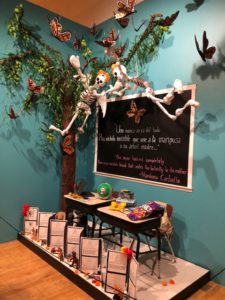 Every fall, I make a pilgrimage to the National Museum of Mexican Art in Pilsen. In the early 1900s, the area, on the near south side of Chicago, was where Immigrants from eastern Europe settled. It’s now a largely Hispanic neighborhood.
Every fall, I make a pilgrimage to the National Museum of Mexican Art in Pilsen. In the early 1900s, the area, on the near south side of Chicago, was where Immigrants from eastern Europe settled. It’s now a largely Hispanic neighborhood.
Colorful murals are painted on the sides of buildings. Upscale restaurants and places for craft cocktails, bars that might be featured in Chicago’s edition of Time Out magazine, provide choices for the gentrified who prefer re-invented Mexican cuisine over old-fashioned taquerias.
I go to the museum each year around Halloween for their Day of the Dead exhibit.
Visiting the Dia de Muertos exhibit is like witnessing the Disney/Pixar movie, Coco, come to life. The exhibit features altars (ofrendas) arranged with photographs, paper flowers, diary pages, favorite foods and personal effects that honor dear ones who died.
In the movie Coco, a young man seeks career advice from his grandfather and is reminded that people live on in the hearts of those who honor them. Walking through the exhibit invites you to experience this.
It’s a strange path, walking through the exhibit, seeing the altars composed of relics that are intensely personal while never making you feel like you’re eavesdropping.
You don’t have to have known the departed to feel like you know them or someone like them.
Looking at the baseball cards they collected or finding out that their hero was an uncle who, as a firefighter, died saving twins trapped in a third story walk-up is both chilling and comforting.
Their lives meant something. All our lives mean something, even if that is just to a small circle of friends and family.
Wandering through the galleries, and seeing love and loss expressed so naturally was especially poignant this year. There were special prints and installations on the death of children.
I don’t have children myself but I do know how the death of child can affect a family. I lost a sister in a car accident several years before I was born. In some ways, I don’t think my family ever recovered.
It’s often been referred to as the worst thing that could happen to a person, the death of one of their children, but everyone loses something when a young person dies.
The death of a child represents the death of innocence and hope, something we all crave. The death of a child also represents a serious crack in our belief in the natural order of things. Old people are supposed to die before the young, right? We can easily lose our ability to trust life.
As I first walked in to the special gallery, there was a very haunting installation of child-sized, white figures forming a short, crooked line. They seemed to be waiting for something that could not be viewed, something that carried neither fear nor joy.
Then, there was a colorful ofrenda to honor the nineteen children who were gunned down at Robb Elementary School in Uvalde, Texas.
Desks, like you’d see in any school, sat in front of a blackboard where the words of poet and actor, Mardonia Carbella were displayed in Spanish and in English. Butterflies stood out against the teal-colored classroom wall and small skeletons hovered over the scene.
“One never leaves completely. There is an invisible thread that unites the butterfly to its mother.”
I never knew — I never experienced the curiosity and openness of Layla or Maranda, Xavier, Jose Manuel or the other ten and eleven year-olds who lost their lives that day in a mostly quiet town in Texas, but I lingered in front of this altar and piece of art.
Somehow, the fact that so many came together to mourn the loss of children that they didn’t know personally provided some level of comfort for me and, I suspect, others.
That art can remind us that everyone knows and shares grief, one the most personal and difficult of emotions, is powerful.
Incredible to think that, when children die, we are all mothers of butterflies. Everyone serves the world by remembering.
When “I” becomes “we,” it is no small thing.

